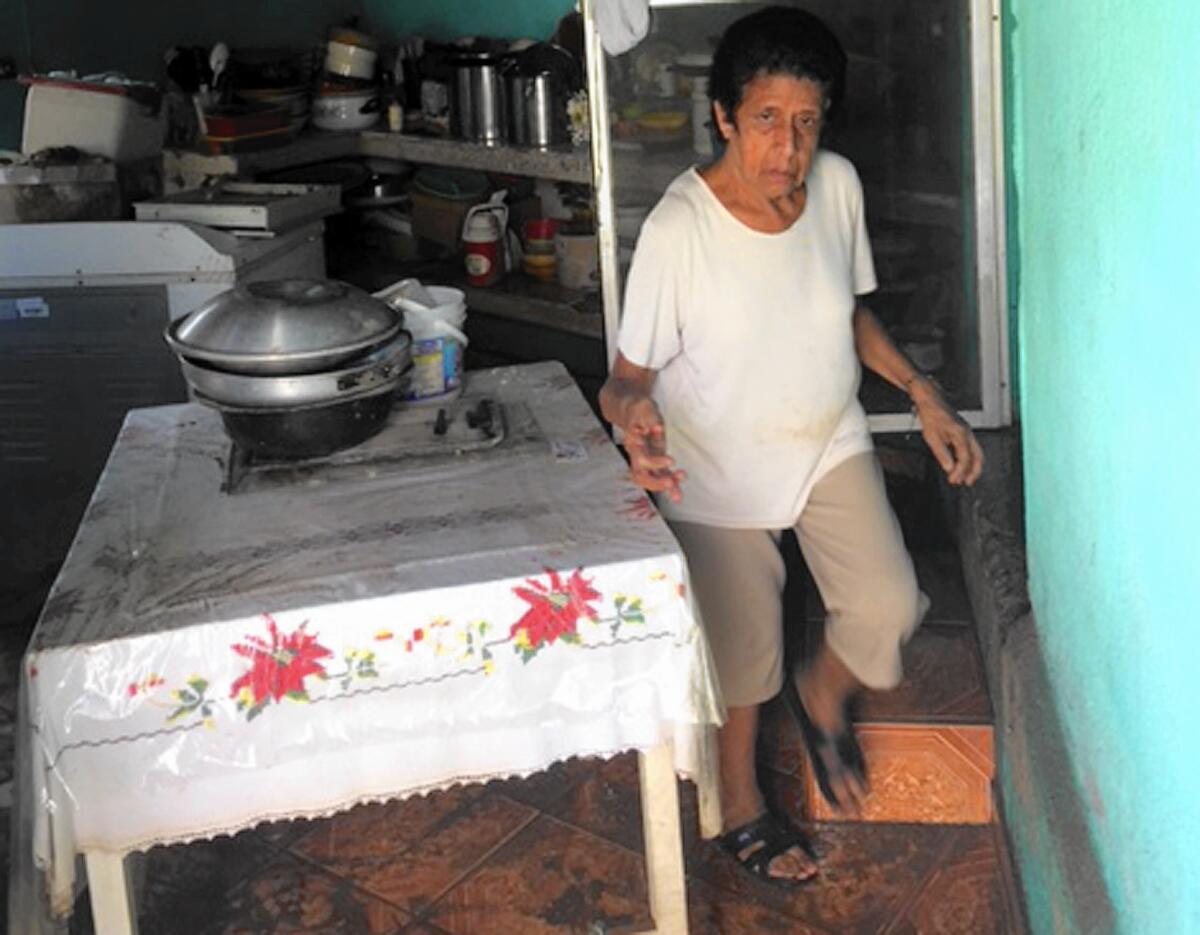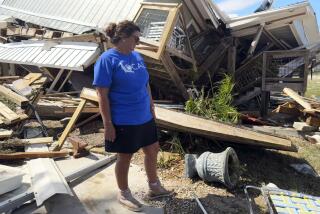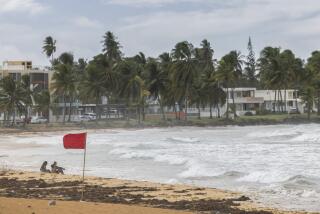Mexicans shovel out after Hurricane Patricia

Genoveva Salcedo, 67, gingerly steps through her muddy home in Cihuatlan, Mexico, after Hurricane Patricia struck.
reporting from CIHUATLAN, Mexico — A rusty sign at the entrance of this town declares a population of 31,850 people and an elevation of 20 meters — about 60 feet — above sea level.
The town sits about nine miles inland from the Pacific Ocean. But the waves were not the problem here early Saturday. It was the river.
Just after midnight, the Marabasco River, swelling with the massive rains of Hurricane Patricia, came rushing into homes near the corner of Abasolo and Diagonal streets, the lowest point in town.
NEWSLETTER: Get the day’s top headlines from Times Editor Davan Maharaj >>
The next afternoon, Francisco Cobian, 58, worked shirtless in his doorway, tossing mud-coated electronics, toys and kitchen utensils into the street.
In one bedroom, toppled furniture was scattered wall-to-wall. In the other, a row of clothes hung in a closet. A crisp line of mud ran across the shirt cuffs, showing exactly how high the water had come.
Cobian said he had lived in the house since he was a boy and planned to move back in as soon as possible.
On Friday afternoon, after the winds began to howl and a municipal pickup came by warning residents through a loudspeaker to leave for higher ground, his wife and two younger children walked up the hill to stay with their older daughter for the night.
Cobian remained in the house until the water arrived. Then, he said, “I ran to be with my family.”
The damage from any storm is a product of its strength and whatever stands in its path.
Patricia, the most intense storm ever measured in the Western Hemisphere while at sea, did not lack strength, still packing 165-mph winds when it made landfall early Friday evening.
But its narrow center struck a place that was sparsely populated, sparing the larger cities of Puerto Vallarta and Manzanillo.
As of Saturday evening, there had been no reports of deaths and few reports of injuries. Patricia seemed like the massive hurricane that wasn’t.
But there still were victims.
And for some of the families in this small town, cleaning up was a case of deja vu.
Four years ago, they said, the river flooded its banks during another storm. Mud washed in. Families saved what they could and threw away the rest.
The government built a dike along the river. But on Friday, the river broke through in one spot, and the water rushed back in.
“We’re getting used to living through these disasters,” said Genoveva Salcedo, 67, who lives across the street from Cobian and was mopping mud out her front door into the street.
Her son, daughter-in-law and grandchild — all of whom live there too — were helping.
On the corner, a government trunk pumped water out of the street through large hoses back to the river. It had been there for hours.
The river was receding, but it was muddy and still moving fast enough to produce whitecaps in spots.
For many here Saturday afternoon, Patricia was already a thing of the past. The sun was beating down. Mopeds buzzed past.
Even Cobian’s wife, Gricella Esparza, 50, had already returned to her job at a tiny bodega just up the hill and around the corner.
“What can I do?” she said. “I’m trying to stay calm.”
Manuel Sepulveda, 66, stopped in and bought two bags of cashews and a yogurt for 27 pesos. His house two blocks away also had flooded. He decided he would wait a day before going back in.
He noted a giant statue of a soldier with a shovel at the entrance to the town. “We’re going to be taking out a lot of mud,” he said.
Neighbor Sigifredo Martinez, 54, said he planned to sleep in a hammock.
“The mattresses are lost,” he said. “The refrigerator too.”
Nearby a team of government workers were gathering to conduct a door-to-door survey to assess the damage.
See the most-read stories this hour >>
Many residents whose houses stayed dry will still pay a price.
The town is surrounded by vast plantations of coconuts and bananas, and those who live in Cihuatlan work the harvests. But the storm destroyed many of the crops.
Francisco Lopez, 63, said he had expected to earn about $600 next month cutting down coconuts. Now he’ll have to wait until at least February, he said.
“The wind blew them down and carried them away,” he said. “They’re gone.”
Special correspondent Cecilia Sanchez contributed to this report.
MORE ON HURRICANE PATRICIA:
Mexicans express relief as once-ferocious Hurricane Patricia weakens
What to know about Patricia, the most intense hurricane ever recorded
One of the strongest hurricanes ever recorded is fueled by El Niño, scientists say
More to Read
Sign up for Essential California
The most important California stories and recommendations in your inbox every morning.
You may occasionally receive promotional content from the Los Angeles Times.











